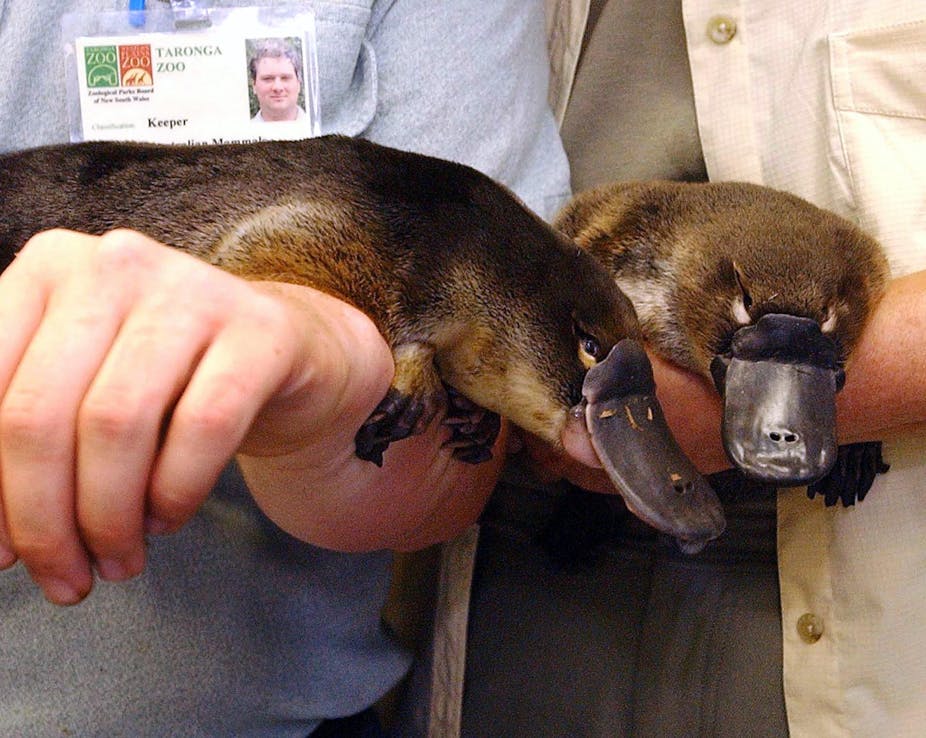Consider two furry Australian animals: the platypus (Ornithorhynchus anatinus) and the Sydney funnel-web spider (Atrax robustus). Both icons in their own way, both live only in Australia and both were thus novelties to the Europeans who arrived to colonise New South Wales in 1788. So why don’t we want to cuddle them both equally?
They are, after all, both venomous creatures.
The historical furore over the platypus is legendary. Long known to local Aboriginal people, Britons first learned of this creature via the popular 1798 account of the new colony by former Lieutenant-Governor, David Collins. Within his brief description, Collins variously likened the platypus to a mole, a duck and a turtle. So what was it? This question – just what this animal was and where it belonged in the order of Creation or, later, evolution – vexed naturalists over the ensuing century. It’s unsurprising that one early scientific moniker was Ornithorhynchus paradoxus – literally “bird-billed paradox”.
Once it was settled that this creature was not a ludicrous hoax, European naturalists set to work creating its identity. They considered its furry coat, warm blood, webbed feet, rubbery bill, its single opening for both reproduction and excretion and – by the 1820s – the presence of milk glands on the female’s underbelly. Bird, reptile or mammal?

Ultimately, blood, fur and milk triumphed. The platypus was declared a primitive mammal, albeit a monotreme (“single hole”). The definition stood, even when it was confirmed in 1884 that the female laid eggs that hatched after birth, like many snakes. Which was curious, because another snake-like characteristic was largely overlooked throughout these categorising negotiations.
As early as 1799 it was noted that male platypuses possessed a sharp spur on their hind legs, through which – Sydney doctor John Jamieson wrote in 1816 – “the animal can, like a serpent, force the poison when it inflicts its wound”. Jamieson detailed the suffering of his servant when spiked by this spur, likening the excruciating pain and prodigious swelling to “all the symptoms of a person bitten by a venomous snake”.
Not unfamiliar to Aboriginal people, this unpleasant envenomation was occasionally shared by colonial fishermen, platypus hunters and their dogs. Yet the anomalous possession of a poison gland, vanishingly rare amongst mammals, swayed neither professional nor public categorisation.
The platypus was warm-blooded, hairy and the female suckled its young – just like humans. By the end of the century it had joined several other charismatic indigenous animals with whom the newly Federated Australians identified. By 1914, not only was hunting the platypus banned; its placid countenance now became a national emblem, adorning anything from Sassafras Tonic to the “Tasmanian University Magazine”.
So what about our furry funnel-webs?
When the British flag was planted at Sydney Cove in 1788, surely the pole disturbed a funnel-web nest and sent His Majesty’s dignified representatives scampering? Not so.
Throughout the nineteenth century Australian colonists were little concerned by spiders, least of all Atrax robustus. Unlike serpents, spiders barely appeared in Christian scripture. While the settlers soon enough shared their airy homes with local huntsman spiders, what was most despised was their “guilty” scuttling away from humans. Despite branding them “triantelopes” or “tarantulas” after reputedly venomous varieties in both the old and new worlds, colonists rarely feared their bite.

Indeed, by 1800 international authorities – including one who encouraged enormous South American bird spiders to bite his slaves – pronounced spider bites harmless to humans. At late as 1889, American experts considering Latrodectus spiders – including their black widow, the Australian redback and the New Zealand katipo – asserted that “Evidence in regard to fatal bites is very weak”.
In part, this was due to different standards of proof. In 1894 Sydney University’s Professor of Medicine, Thomas Anderson Stuart, observed that bite reports were “neither numerous nor complete in the medical literature of Australasia, while the stories of the spiders are known to everyone”. But he was referring to redbacks and katipos; absent from any Australasian discourse about spiders until 1927 was the funnel-web.
When first describing Atrax robustus in 1877, British arachnologist Octavius Pickard Cambridge referred to this “primitive” spider’s “large, massive and very prominent” fangs. But he passed little further comment when categorising it alongside similarly hairy specimens from across the globe.
Neither Aborigines nor a century’s worth of settlers had recorded any untoward encounters. Thus when – a full 50 years later – unfortunate 2-year-old Clyde Thompson died after playfully squashing a funnel-web, the attending doctor admitted that “death from a spider bite is an extremely rare occurrence”.
Nevertheless, world opinion was changing. Australians too were ready to accord spiders a malevolent potency. Once the investigating constable dragged the accused spider – “a big black one” – into the coroner’s court, the case was closed. Within a decade, local arachnologist Keith McKeown declared that the funnel-web was “known throughout the country on account of its deadliness to man”.
But McKeown also posed a question asked by many Australians after 1927: why had no-one previously feared the funnel-web?
As the platypus illustrated, it took more than the possession of poison or a handful of cases to render an indigenous animal “dangerous”. Much of the shift related to proximity and purpose.
Once they came to accept themselves as its Darwinian descendants, urban Australians viewed the platypus over zoo walls and concurred that this playful monotreme sported its poison spur for defence – or possibly mating.
Funnel-webs, however, wielded fangs like snakes and were thus doubly offensive: not merely killers, they “invaded” the safety of suburban gardens, outhouses and bedrooms. Neither passive playthings nor timorous triantelopes, these pugnacious arachnids heralded a dawning awareness that nature might just bite back.

